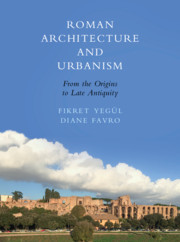Book contents
- Roman Architecture and Urbanism
- Roman Architecture and Urbanism
- Copyright page
- Contents
- Preface and Acknowledgments
- Maps
- Introduction
- 1 Urban Design and Architecture in Rome and Italy during the Republic and the Early Empire
- 2 Temple Architecture of Republican Rome and Italy
- 3 Technology of Building
- 4 Julio-Claudian Architecture in Rome
- 5 Residential Architecture
- 6 Imperial Architecture in Rome from the Flavians through the Antonines
- 7 Architecture and Planning in Italy and the Western Provinces
- 8 Architecture and Planning in North Africa
- 9 Greece under Roman Rule
- 10 Architecture and Planning in Asia Minor
- 11 The Roman Near East
- 12 The Late Empire in Rome and the Provinces
- General Bibliography
- Glossary
- Index
- Plate Section (PDF Only)
- References
5 - Residential Architecture
Published online by Cambridge University Press: 21 August 2019
- Roman Architecture and Urbanism
- Roman Architecture and Urbanism
- Copyright page
- Contents
- Preface and Acknowledgments
- Maps
- Introduction
- 1 Urban Design and Architecture in Rome and Italy during the Republic and the Early Empire
- 2 Temple Architecture of Republican Rome and Italy
- 3 Technology of Building
- 4 Julio-Claudian Architecture in Rome
- 5 Residential Architecture
- 6 Imperial Architecture in Rome from the Flavians through the Antonines
- 7 Architecture and Planning in Italy and the Western Provinces
- 8 Architecture and Planning in North Africa
- 9 Greece under Roman Rule
- 10 Architecture and Planning in Asia Minor
- 11 The Roman Near East
- 12 The Late Empire in Rome and the Provinces
- General Bibliography
- Glossary
- Index
- Plate Section (PDF Only)
- References
Summary
A small hut constructed of poles, mud, and thatch was lovingly maintained for centuries atop the Palatine Hill in Rome (). The structure memorialized the original residence of Romulus, Rome’s mythical founder. By the late Republic, the humble hut nestled amid upper-class family residences embellished with imported sculpture, colorful wall paintings, and lush plantings, explicitly affirmed both the Romans’ humble beginnings and how far they had progressed. Research and data on Roman housing and house types are extensive. For the capital city texts preserve information about the use and status associated with various forms of domestic architecture. Particularly useful is the marble plan where whole streets of atrium-type houses as well as multistoried tenements are shown on some fragments (see ). Official lists catalog the types and numbers of residences. As the population of Rome exploded, the more desirable single-family domus courtyard house competed with high-rise insulae climbing the hillsides as well as with row houses and live/work units lining the streets in the flatlands. However, despite exceptions, archaeological evidence for residential architecture in Rome is fragmentary and incomplete.
- Type
- Chapter
- Information
- Roman Architecture and UrbanismFrom the Origins to Late Antiquity, pp. 244 - 293Publisher: Cambridge University PressPrint publication year: 2019



